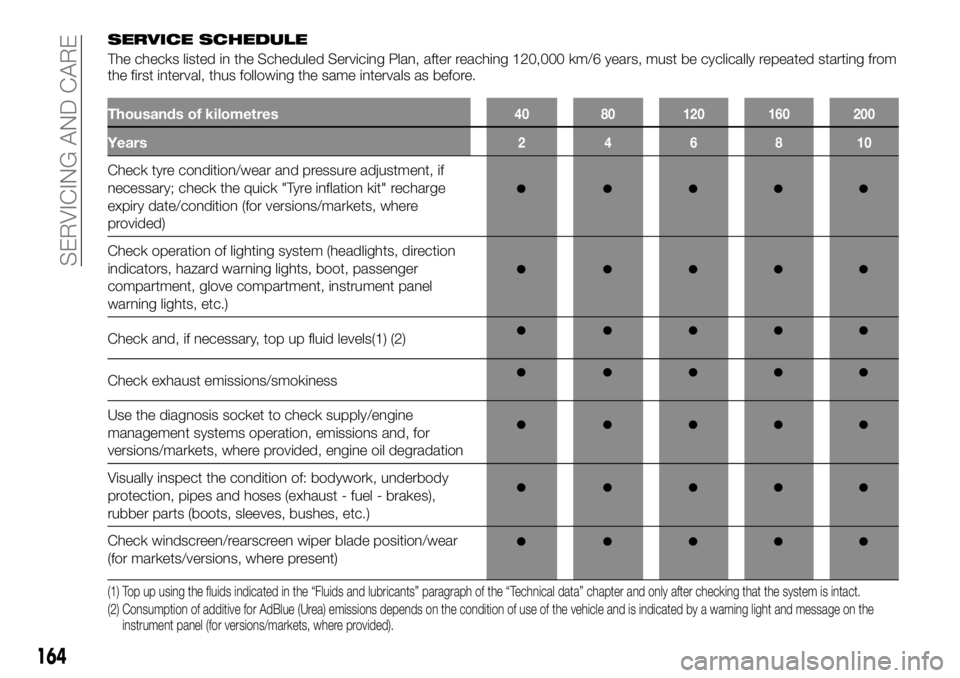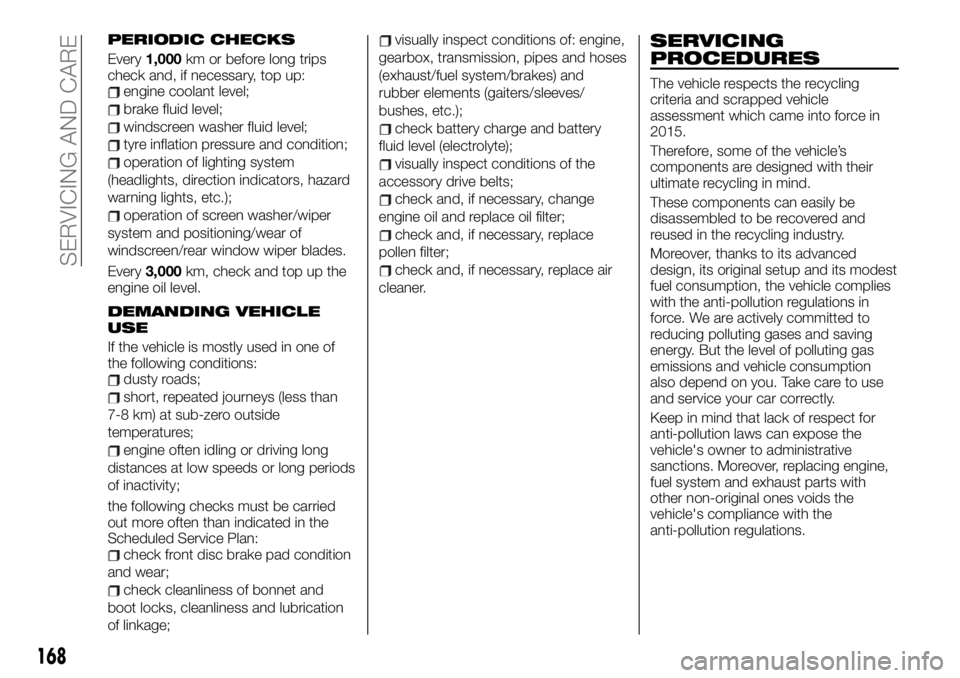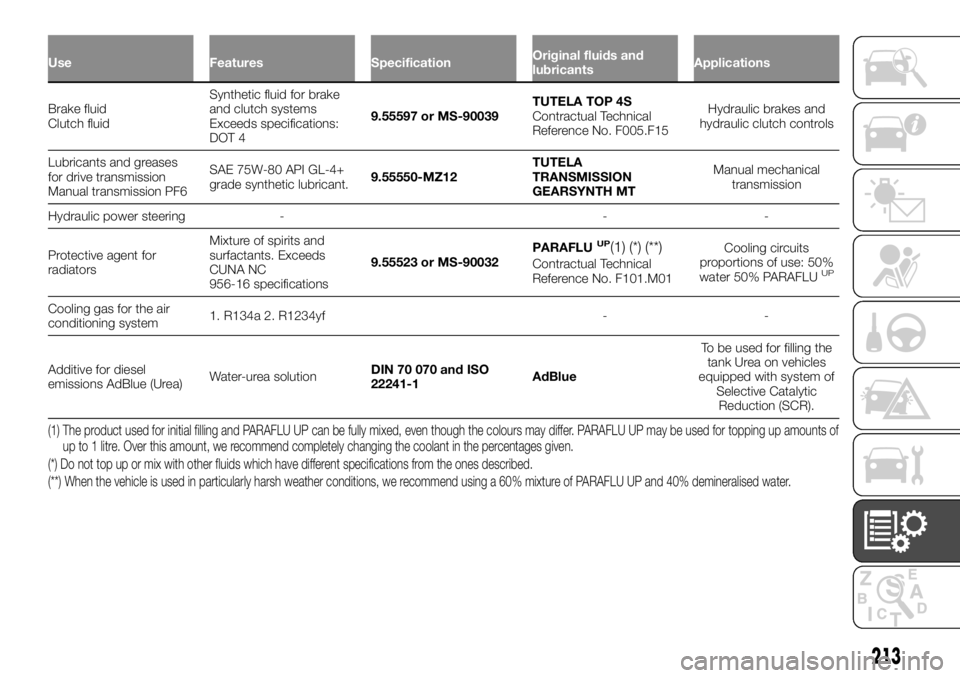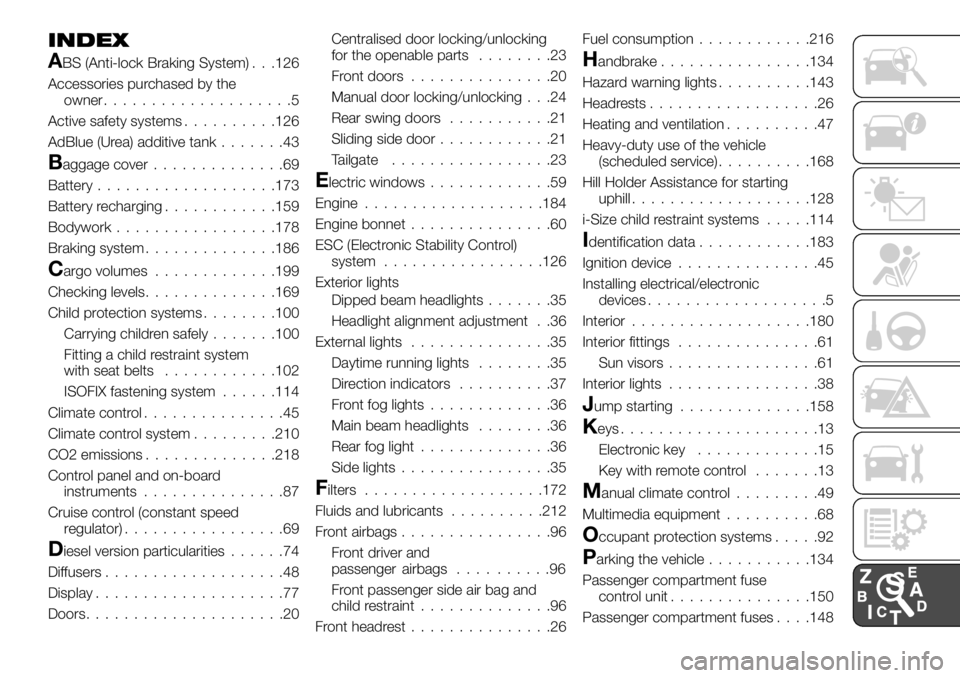brake fluid FIAT TALENTO 2021 Owner handbook (in English)
[x] Cancel search | Manufacturer: FIAT, Model Year: 2021, Model line: TALENTO, Model: FIAT TALENTO 2021Pages: 236, PDF Size: 4.86 MB
Page 166 of 236

SERVICE SCHEDULE
The checks listed in the Scheduled Servicing Plan, after reaching 120,000 km/6 years, must be cyclically repeated starting from
the first interval, thus following the same intervals as before.
Thousands of kilometres40 80 120 160 200
Years246810
Check tyre condition/wear and pressure adjustment, if
necessary; check the quick "Tyre inflation kit" recharge
expiry date/condition (for versions/markets, where
provided)
Check operation of lighting system (headlights, direction
indicators, hazard warning lights, boot, passenger
compartment, glove compartment, instrument panel
warning lights, etc.)
Check and, if necessary, top up fluid levels(1) (2)
Check exhaust emissions/smokiness
Use the diagnosis socket to check supply/engine
management systems operation, emissions and, for
versions/markets, where provided, engine oil degradation
Visually inspect the condition of: bodywork, underbody
protection, pipes and hoses (exhaust - fuel - brakes),
rubber parts (boots, sleeves, bushes, etc.)
Check windscreen/rearscreen wiper blade position/wear
(for markets/versions, where present)
(1) Top up using the fluids indicated in the “Fluids and lubricants” paragraph of the “Technical data” chapter and only after checking that the system is intact.
(2) Consumption of additive for AdBlue (Urea) emissions depends on the condition of use of the vehicle and is indicated by a warning light and message onthe
instrument panel (for versions/markets, where provided).
164
SERVICING AND CARE
Page 167 of 236

Thousands of kilometres40 80 120 160 200
Years246810
Check operation of the windscreen wiper/washer system
and adjust jets, if necessary
Check cleanliness of bonnet and boot locks, cleanliness
and lubrication of linkage
Visually check front disc brake pad condition and wear
Visually check rear disc brake pad condition and wear
Visually inspect the accessories drive belt/s condition
Check accessory drive belt tensioning
Change engine oil and replace oil filter(3)
Replacing accessories drive belt/s(4)
Replace fuel filter cartridge(5)
Replace air cleaner cartridge(6)
Change the brake fluid(6)
(3) The actual interval for changing engine oil and replacing the engine oil filter depends on the vehicle usage conditions and is signalled by the warning light or
message on the instrument panel. It must never exceed 2 years or 40,000 km. Change engine oil and filter every year if the vehicle is driven mainly in town.
(4) Areas that are not dusty: recommended maximum mileage 160,000 km. Regardless of the mileage, the belt must be replaced every 6 years. Dusty areas and/or
heavy conditions (cold climates, urban driving, long periods of idling): the recommended maximum distance is 60,000 km. Regardless of the mileage, the belt
must be replaced every 4 years.
(5) When refuelling the vehicle with a quality below the relevant European specification, this filter must be replaced every 20,000 km
(6) Replacing it every 4 years or 120,000 km is recommended
165
Page 170 of 236

PERIODIC CHECKS
Every1,000km or before long trips
check and, if necessary, top up:
engine coolant level;
brake fluid level;
windscreen washer fluid level;
tyre inflation pressure and condition;
operation of lighting system
(headlights, direction indicators, hazard
warning lights, etc.);
operation of screen washer/wiper
system and positioning/wear of
windscreen/rear window wiper blades.
Every3,000km, check and top up the
engine oil level.
DEMANDING VEHICLE
USE
If the vehicle is mostly used in one of
the following conditions:
dusty roads;
short, repeated journeys (less than
7-8 km) at sub-zero outside
temperatures;
engine often idling or driving long
distances at low speeds or long periods
of inactivity;
the following checks must be carried
out more often than indicated in the
Scheduled Service Plan:
check front disc brake pad condition
and wear;
check cleanliness of bonnet and
boot locks, cleanliness and lubrication
of linkage;
visually inspect conditions of: engine,
gearbox, transmission, pipes and hoses
(exhaust/fuel system/brakes) and
rubber elements (gaiters/sleeves/
bushes, etc.);
check battery charge and battery
fluid level (electrolyte);
visually inspect conditions of the
accessory drive belts;
check and, if necessary, change
engine oil and replace oil filter;
check and, if necessary, replace
pollen filter;
check and, if necessary, replace air
cleaner.
SERVICING
PROCEDURES
The vehicle respects the recycling
criteria and scrapped vehicle
assessment which came into force in
2015.
Therefore, some of the vehicle’s
components are designed with their
ultimate recycling in mind.
These components can easily be
disassembled to be recovered and
reused in the recycling industry.
Moreover, thanks to its advanced
design, its original setup and its modest
fuel consumption, the vehicle complies
with the anti-pollution regulations in
force. We are actively committed to
reducing polluting gases and saving
energy. But the level of polluting gas
emissions and vehicle consumption
also depend on you. Take care to use
and service your car correctly.
Keep in mind that lack of respect for
anti-pollution laws can expose the
vehicle's owner to administrative
sanctions. Moreover, replacing engine,
fuel system and exhaust parts with
other non-original ones voids the
vehicle's compliance with the
anti-pollution regulations.
168
SERVICING AND CARE
Page 172 of 236

Unscrew cap 1 fig. 274;
restore the level (the approximate
amount to get between the dipstick 2
"min" and "max" levels is about 1.5 and
2 litres, depending on the engine);
wait about 10 seconds to let the oil
flow in the circuit;
check the level with the dipstick 2
fig. 274 (as described above).
Once the operation is done, insert the
dipstick as far as it will go or screw the
cap back on completely.
IMPORTANT To avoid splashing, use a
funnel when topping up/filling up.
IMPORTANT Never exceed the "max"
level and do not forget to put the cap
1 back on and dipstick 2 fig. 274 in
place.
201) 199) 200) 202) 203) 204) 205) 206) 207) 208)
Change engine oil
Contact a Fiat Dealership.Amount of oil to replace
Always check the oil level with the
dipstick (it must never be below the
MIN level nor above the MAX level).
Engine oil quality
Refer to the “Fluids and lubricants”
paragraph on the “Technical data”
chapter.
IMPORTANT In case of unusual,
repeated drop, see a Fiat Dealership.
BRAKE FLUID
The level is checked with the engine
stopped and on a horizontal surface.
It has to be checked often and in any
case every time there is a minimum
variation in the braking system.Level 2 fig. 275
Normally the level drops along with the
brake pad wear, but it should not drop
below the warning threshold "MIN".
212) 213)
45) 49)
Filling
Every operation on the hydraulic circuit
involves replacing the fluid by a
specialised technician.
Use an approved fluid only (taken from
a new pack).
Replacement
Refer to the Scheduled Service Plan (in
this chapter).
IMPORTANT In case of unusual,
repeated drop, see a Fiat Dealership.
COOLANT LIQUID
With the engine off, on a level surface,
the cold level should be between "MIN"
and "MAX" indicated on coolant tank 1
fig. 276.
IMPORTANT In case of unusual,
repeated drop, see a Fiat Dealership.
274T36610
275T36609
170
SERVICING AND CARE
Page 174 of 236

209)The cooling system is pressurised. If
the cap needs replacing, do so with
another original or the effectiveness of the
system may be compromised. Do not
remove the reservoir plug when the engine
is hot: you risk scalding yourself.
210)Do not travel if the windscreen
washer reservoir is empty: using the
windscreen washer is essential for
improving visibility. Repeated operation of
the system without fluid could damage or
cause rapid deterioration of some system
components.
211)Some commercial additives for
windscreen washer fluid are flammable.
The engine compartment contains hot
components which may start a fire.
212)Brake fluid is poisonous and highly
corrosive. In the event of accidental
contact, immediately wash the affected
parts with water and mild soap. Then rinse
thoroughly. Call a doctor immediately if
swallowed.
213)The symbol
, on the brake fluid
container indicates if a brake fluid is
synthetic or mineral-based. Use of mineral
type fluids will irreparably damage the
braking system’s special rubber seals.
IMPORTANT
44)In any case, you should not exceed the
maximum filling level: you risk damaging the
engine and catalytic converter. If the
maximum level has been exceeded, do not
start the vehicle; contact the Fiat
Dealership.45)Be careful not to confuse the various
types of fluids while topping up: they are
not compatible with each other! Topping up
with an unsuitable fluid could severely
damage the vehicle.
46)The oil level must never exceed the
MAX. mark.
47)Always top up using engine oil of the
same specifications as that already in the
engine.
48)PARAFLU UP protective anti-freeze is
used in the engine cooling system. Use
fluid of the same type as that contained in
the cooling system for any top-ups.
PARAFLU UP liquid cannot be mixed with
any other type of fluid. If this happens, do
not start the engine under any
circumstances and contact a Fiat
Dealership.
49)Prevent brake fluid, which is highly
corrosive, from coming into contact with
painted parts. Should it happen,
immediately wash with water.
IMPORTANT
5)The used engine oil and the filter that has
been replaced contain substances that are
harmful to the environment. To change the
oil and filters, we advise you to contact a
Fiat Dealership.
FILTERS
Replacement of filtering components
(air filter, passenger compartment filter,
oil filter, etc.) is provided in the vehicle's
Scheduled Service Plan.
Replacement
Please see the Scheduled Service Plan.
172
SERVICING AND CARE
Page 210 of 236

REFUELLING
Use Multijet 115 (Euro 5) Ecojet 120 (Euro 4 – Euro
5) – Ecojet 140 (Euro 5)Recommended fuels
and original lubricants
Diesel engine lubricants (litres) 6.0 7.4SELENIA WR
FORWARD
5W-30 Contractual
Technical Reference No.
(F023.N15)
For non-Europe markets:
SELENIA
MULTIPOWER C3
Contractual Technical
Reference N° (F129.F11)
Protective agent for
radiators (litres)Without climate control
system8.3 9.5
PARAFLU UP
Contractual Technical
Reference No. F101.M01 With climate control
system9.9 11.0
Brake fluid (kg) 1.057TUTELA TOP 4S
Contractual Technical
Reference N° F001.A93
Lubricants and greases for drive transmission (litres) 2.7(TUTELA
TRANSMISSION
GEARSYNTH MT)
Contractual Technical
Reference N° F005.D16
Hydraulic power steering (litres)1.13
1.13 (right hand drive versions)
1.21 (left hand drive versions)–
208
TECHNICAL DATA
Page 211 of 236

Use Multijet 95 – Multijet
120 (Euro 6)Ecojet 95 – Ecojet 125 –
Ecojet 145 (Euro 6)Recommended fuels
and original lubricants
Diesel engine lubricants (litres) 6.0 7.4SELENIA WR
FORWARD 5W-30
Contractual Technical
Reference No. (F023.N15)
Protective agent for
radiators (litres)Without climate control
system8.3 9.5
PARAFLU UP
Contractual Technical
Reference No. F101.M01 With climate control
system9.9 11.0
Brake fluid (kg) 1.057TUTELA TOP 4S
Contractual Technical
Reference N° F001.A93
Lubricants and greases for drive transmission (litres) 2.7(TUTELA
TRANSMISSION
GEARSYNTH MT)
Contractual Technical
Reference N° F005.D16
Hydraulic power steering (litres)1.13
1.13 (right hand drive versions)
1.21 (left hand drive versions)–
AdBlue (Urea) tank (litres)
(for versions/markets, where provided)20 20AdBlue (water-Urea
solution) standard DIN
70 070 and ISO 22241-1
231) 232)
209
Page 215 of 236

Use Features SpecificationOriginal fluids and
lubricantsApplications
Brake fluid
ClutchfluidSynthetic fluidfor brake
and clutch systems
Exceeds specifications:
DOT 49.55597 or MS-90039TUTELA TOP 4S
Contractual Technical
Reference No. F005.F15Hydraulic brakes and
hydraulic clutch controls
Lubricants and greases
for drive transmission
Manual transmission PF6SAE 75W-80 API GL-4+
grade synthetic lubricant.9.55550-MZ12TUTELA
TRANSMISSION
GEARSYNTH MTManual mechanical
transmission
Hydraulic power steering - - -
Protective agent for
radiatorsMixture of spirits and
surfactants. Exceeds
CUNA NC
956-16 specifications9.55523 or MS-90032PARAFLU
UP(1) (*) (**)
Contractual Technical
Reference No. F101.M01Cooling circuits
proportions of use: 50%
water 50% PARAFLUUP
Cooling gas for the air
conditioning system1. R134a 2. R1234yf - -
Additive for diesel
emissions AdBlue (Urea)Water-urea solutionDIN 70 070 and ISO
22241-1AdBlueTo be used for filling the
tank Urea on vehicles
equipped with system of
Selective Catalytic
Reduction (SCR).
(1) The product used for initial filling and PARAFLU UP can be fully mixed, even though the colours may differ. PARAFLU UP may be used for topping up amounts of
up to 1 litre. Over this amount, we recommend completely changing the coolant in the percentages given.
(*) Do not top up or mix with other fluids which have different specifications from the ones described.
(**) When the vehicle is used in particularly harsh weather conditions, we recommend using a 60% mixture of PARAFLU UP and 40% demineralised water.
213
Page 233 of 236

INDEX
ABS (Anti-lock Braking System) . . .126
Accessories purchased by the
owner....................5
Active safety systems..........126
AdBlue (Urea) additive tank.......43
Baggage cover..............69
Battery...................173
Battery recharging............159
Bodywork.................178
Braking system..............186
Cargo volumes.............199
Checking levels..............169
Child protection systems........100
Carrying children safely.......100
Fitting a child restraint system
with seat belts............102
ISOFIX fastening system......114
Climate control...............45
Climate control system.........210
CO2 emissions..............218
Control panel and on-board
instruments...............87
Cruise control (constant speed
regulator).................69
Diesel version particularities......74
Diffusers...................48
Display....................77
Doors.....................20Centralised door locking/unlocking
for the openable parts........23
Front doors...............20
Manual door locking/unlocking . . .24
Rear swing doors...........21
Sliding side door............21
Tailgate.................23
Electric windows.............59
Engine...................184
Engine bonnet...............60
ESC (Electronic Stability Control)
system.................126
Exterior lights
Dipped beam headlights.......35
Headlight alignment adjustment . .36
External lights...............35
Daytime running lights........35
Direction indicators..........37
Front fog lights.............36
Main beam headlights........36
Rear fog light..............36
Side lights................35
Filters...................172
Fluids and lubricants..........212
Front airbags................96
Front driver and
passenger airbags . . . . ......96
Front passenger side air bag and
child restraint..............96
Front headrest...............26Fuel consumption............216
Handbrake................134
Hazard warning lights..........143
Headrests..................26
Heating and ventilation..........47
Heavy-duty use of the vehicle
(scheduled service)..........168
Hill Holder Assistance for starting
uphill...................128
i-Size child restraint systems.....114
Identification data............183
Ignition device...............45
Installing electrical/electronic
devices...................5
Interior...................180
Interior fittings...............61
Sun visors................61
Interior lights................38
Jump starting..............158
Keys.....................13
Electronic key.............15
Key with remote control.......13
Manual climate control.........49
Multimedia equipment..........68
Occupant protection systems.....92
Parking the vehicle...........134
Passenger compartment fuse
control unit...............150
Passenger compartment fuses. . . .148